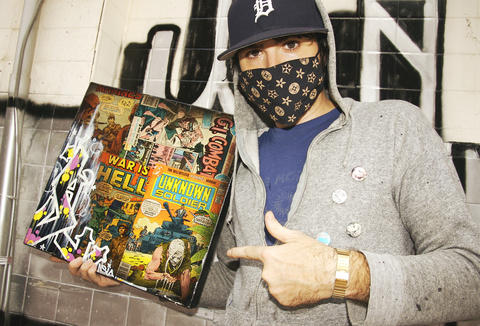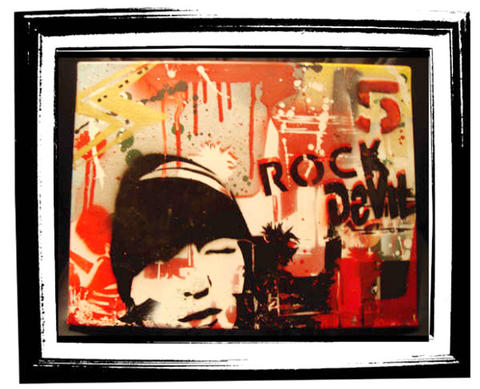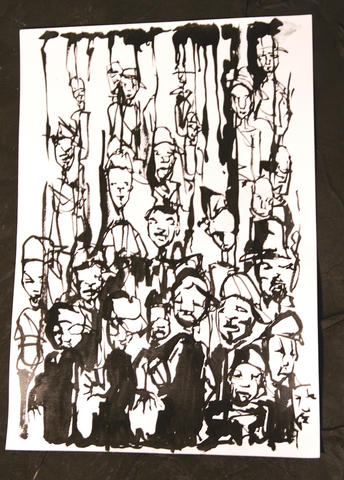Group 13 moves graffiti from the street into the gallery. The curator takes scrawls in an alley and passes them off as legitimate works of art. It's a transformation that has already happened elsewhere but has found a home of sorts in Taipei, at AMPM.
The Canadian aerosol artist Dbsk1 founded the gallery in Ximending at the beginning of the year and it has held a number of graffiti and photography exhibitions, including installations.
The route from avant-garde to mainstream, from the underground to overground, is a well-trodden one and the only surprise is established gallery owners here have not capitalized on it sooner.

PHOTOS: JULES QUARTLY, TAIPEI TIMES
"We show the low-brow and underground because no-one else is doing that here. At home [Montreal] there's plenty of shows," says Dbsk1, who uses a number of aliases and is usually photographed with a face mask.
"I have to protect myself. I still do a lot of street stuff and it also keeps the mysterious street scene vibe goin', as opposed to the commercial scene."
Writing graffiti in Taipei is a public order offence under the category of defacing public property and offenders are subject to fines of NT$4,500.

In practice, however, the authorities are fairly lenient and Taipei seems liberal compared with some Western countries. Dbsk1 says he has been pulled a couple of times for tagging but was not fined.
In the UK, former prime minister Tony Blair signed a charter saying, "Graffiti is not art, it's crime," New York set up an anti-graffiti task force and Chicago fines perpetrators US$500.
"It's more easygoing than back in Canada. There's places here where you can do stuff legally - like the levee walls - and where it's kinda accepted," Dbsk1 says.

You can check graffiti out for yourself at sites like the Jianguo Beer Factory, Huashan Culture Park, all around Ximending (especially Cinema Park) and the East Side shopping district around Zhongxiao East Road.
CityStalker is possibly the most famous/infamous local graffiti artist and has been working since 2000, when tags in New Zealand inspired him. He was caught once in Ximending.
"I was working on a piece and this guy was watching me, but I paid no attention. Then the police turned up and it turned out the guy watching was a community officer," CityStalker says.
"They started writing me a red ticket when the [community officer] says, 'Why don't you let him finish the piece, it will look better if he does.'"
Despite the gallery, Dbsk1 emphasizes the "close-to-the-edge" buzz of illegal graffiti work. He admits to walking a "blurry line" between sellout and commercial artist.
Though he has done work for Philips, the city's MRT company and worked as a graphic artist on games, the credibility factor is important to him.
CityStalker, on the other hand, seems more comfortable with the transition. He studied art at college and calls himself a "new school artist," working primarily with stencils and spray paint.
He sees the AMPM show as a way to move out of the shadows and into the spotlight, where he can make a living doing what he's good at.
From its anti-establishment roots in 1970s New York, graffiti has moved from the underpass into the art arena where it is commoditized.
It mirrors the history of art production, which often begins with outsiders and the critics saying, 'That's not art,' then it becomes the norm.
Writing graffiti is as ancient as cave painting and tagging is about as basic as a dog marking its territory by urinating against the wall. Even so, in addition to being ascribed a value, graffiti has developed an aesthetic.
As such, the artist's medium has changed even though the intent is the same, namely to express something. The 13 local and international artists presented at AMPM all do so in fresh, colorful and innovative ways.
From the lettering and anime-inspired work of Jahan, to the graphic designs of Winston and combo lettering of Dabs1, the Group 13 Exhibition shows off the best in local street art.
Trick and Utah's photo installation, Setr's freight train documentary and the film Reefer Madness add to the mix. There will also be DJs, refreshments and an art raffle at the opening.

April 14 to April 20 In March 1947, Sising Katadrepan urged the government to drop the “high mountain people” (高山族) designation for Indigenous Taiwanese and refer to them as “Taiwan people” (台灣族). He considered the term derogatory, arguing that it made them sound like animals. The Taiwan Provincial Government agreed to stop using the term, stating that Indigenous Taiwanese suffered all sorts of discrimination and oppression under the Japanese and were forced to live in the mountains as outsiders to society. Now, under the new regime, they would be seen as equals, thus they should be henceforth

Last week, the the National Immigration Agency (NIA) told the legislature that more than 10,000 naturalized Taiwanese citizens from the People’s Republic of China (PRC) risked having their citizenship revoked if they failed to provide proof that they had renounced their Chinese household registration within the next three months. Renunciation is required under the Act Governing Relations Between the People of the Taiwan Area and the Mainland Area (臺灣地區與大陸地區人民關係條例), as amended in 2004, though it was only a legal requirement after 2000. Prior to that, it had been only an administrative requirement since the Nationality Act (國籍法) was established in

With over 80 works on display, this is Louise Bourgeois’ first solo show in Taiwan. Visitors are invited to traverse her world of love and hate, vengeance and acceptance, trauma and reconciliation. Dominating the entrance, the nine-foot-tall Crouching Spider (2003) greets visitors. The creature looms behind the glass facade, symbolic protector and gatekeeper to the intimate journey ahead. Bourgeois, best known for her giant spider sculptures, is one of the most influential artist of the twentieth century. Blending vulnerability and defiance through themes of sexuality, trauma and identity, her work reshaped the landscape of contemporary art with fearless honesty. “People are influenced by

Three big changes have transformed the landscape of Taiwan’s local patronage factions: Increasing Democratic Progressive Party (DPP) involvement, rising new factions and the Chinese Nationalist Party’s (KMT) significantly weakened control. GREEN FACTIONS It is said that “south of the Zhuoshui River (濁水溪), there is no blue-green divide,” meaning that from Yunlin County south there is no difference between KMT and DPP politicians. This is not always true, but there is more than a grain of truth to it. Traditionally, DPP factions are viewed as national entities, with their primary function to secure plum positions in the party and government. This is not unusual